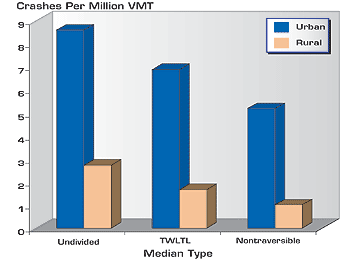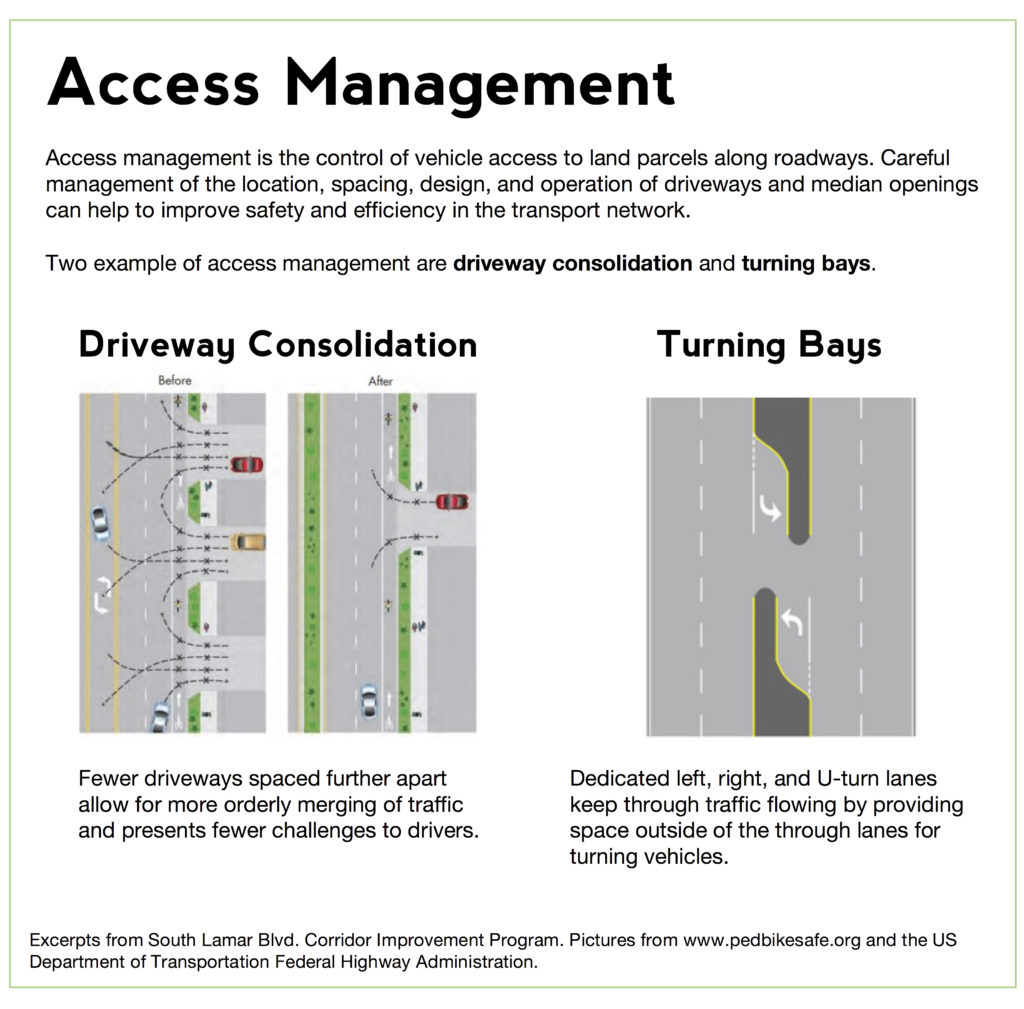The question has come up about how raised medians, consolidated driveways, and left-turn and right-turn lanes, which are grouped together in mobility jargon as “access management,” improve traffic congestion, the top priority of the mobility bond. At first glance, taking away the chicken lane in the middle of a four-lane urban road and adding dedicated turn lanes while limiting drive ways doesn’t seem like it would address slow traffic.
The answer becomes clear, however, when you ask a different question: Do traffic accidents cause traffic delays? Of course they do, so anything we can reduce traffic collisions on busy roads will reduce traffic congestion. What makes intuitive sense to you and me is backed up by the Federal Highways Administration at the U.S. Department of Transportation.
Raised Medians
Right now on the old state highways such as North and South Lamar, Burnet Road, and MLK, the roads are either undivided or, more often, split by what you and I call “suicide” or “chicken” lanes and what the experts call “two-way left turns”.
 According to the FWA, “The safety benefits of median improvements have been the subject of numerous studies and syntheses. Studies of both particular corridors and comparative research on different types of median treatments indicate the significant safety benefits from access management techniques,” according to the Federal Highway Administration’s Benefits of Access Management Brochure. “According to an analysis of crash data in seven states, raised medians reduce crashes by over 40 percent in urban areas… Raised medians also provide extra protection for pedestrians. A study of median treatments in Georgia found that raised medians reduced pedestrian-involved crashes by 45 percent and fatalities by 78 percent, compared to two-way left-turn lanes.”
According to the FWA, “The safety benefits of median improvements have been the subject of numerous studies and syntheses. Studies of both particular corridors and comparative research on different types of median treatments indicate the significant safety benefits from access management techniques,” according to the Federal Highway Administration’s Benefits of Access Management Brochure. “According to an analysis of crash data in seven states, raised medians reduce crashes by over 40 percent in urban areas… Raised medians also provide extra protection for pedestrians. A study of median treatments in Georgia found that raised medians reduced pedestrian-involved crashes by 45 percent and fatalities by 78 percent, compared to two-way left-turn lanes.”
And fewer accidents means fewer traffic delays.
Others have raised concerns about how raised medians could impede access to businesses on the other side of the street, but the Federal Highway Administration says studies indicate otherwise.
Though there are few studies of the actual impacts of medians on business sales, there are several surveys of business owner opinions. Surveys conducted in multiple corridors in Texas, Iowa, and Florida demonstrate that the vast majority of business owners believe there have been no declines in sales, with some believing there are actually improvements in business sales. [2,5,8] One study in Texas indicated that corridors with access control improvements experienced an 18 percent increase in property values after construction. [2]
Consolidated Driveways
 Consolidated driveways are another way to improve traffic by limiting traffic accidents. The basic rule of thumb is that the more driveways there are, the more potential conflicts there are on a road. The more potential conflicts, the more accidents, and the more traffic delays.
Consolidated driveways are another way to improve traffic by limiting traffic accidents. The basic rule of thumb is that the more driveways there are, the more potential conflicts there are on a road. The more potential conflicts, the more accidents, and the more traffic delays.
Consolidating driveways increase the potential conflicts on a particular road. If the driveways are spaced out, then the same number of cars can merge into traffic in a more orderly and safer manner. The evidence that the FHA presents seems to bear that out.
The congestion impacts of reduced driveways are fairly clear.
It is impossible for a major arterial or highway to maintain free flow speeds with numerous access points that add slow moving vehicles. A research synthesis found that roadway speeds were reduced an average of 2.5 miles per hour for every 10 access points per mile, up to a maximum of a 10 miles per hour reduction (at 40 access points per mile). [4] With higher numbers of access points, congestion will increase significantly.
An overabundance of driveways also increases the rate of car crashes. An examination of crash data in seven states indicated found a strong linear relationship between the number of crashes and the number of driveways.
Dedicated Turn Lanes
Likewise, building dedicated left- and right-turn lanes reduce delays, but in different ways. The primary danger of trying to turn left in a road without a dedicated turn lane is getting rear-ended, and building these lanes, of course, reduces such collisions. Furthermore, the evidence suggests that there’s a significant increase in the road’s overall capacity of these roads when you build a dedicated left-turn lane.
Left-turn lanes at intersections substantially reduce rear-end crashes. A major synthesis of research on left-turn lanes demonstrated that exclusive turn lanes reduce crashes between 18 to 77 percent (50 percent average) and reduce rear-end collisions between 60 and 88 percent. [4]
Left-turn lanes also substantially increase the capacity of many roadways. A shared leftturn and through lane has about 40 to 60 percent the capacity of a standard through lane. [4]. A synthesis of research on this topic found a 25 percent increase in capacity, on average, for roadways that added a left-turn lane. [13]
Right-turn lanes, on the other hand, are a problem of compounded delays. There is no causal link between unsafe conditions and delays. In the case of not having right-turn lanes, the direct cause is traffic congestion, not collisions, according to the Federal Highway Administration.
Right-turn lanes typically have a less substantial impact on crashes and roadway capacity than other types of turn strategies, because there are fewer limitations on right turns. Though there are fewer studies of these impacts, there is a clear relationship between the number of vehicles attempting a right turn in a through traffic lane and its delay to through traffic. This relationship is exponential – each additional car that must wait for a right turn will increase the delay more than the previous car. At intersections with substantial right-turn movements, a dedicated right-turn lane segregates these cars from through traffic and increases the capacity of the road.
